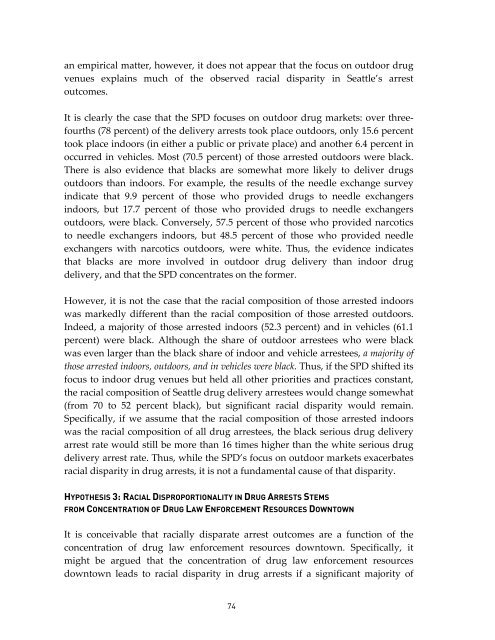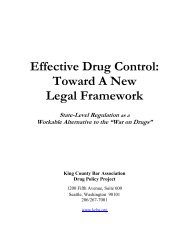RACE AND THE ENFORCEMENT OF DRUG DELIVERY LAWS IN ...
RACE AND THE ENFORCEMENT OF DRUG DELIVERY LAWS IN ...
RACE AND THE ENFORCEMENT OF DRUG DELIVERY LAWS IN ...
Create successful ePaper yourself
Turn your PDF publications into a flip-book with our unique Google optimized e-Paper software.
an empirical matter, however, it does not appear that the focus on outdoor drug<br />
venues explains much of the observed racial disparity in Seattle’s arrest<br />
outcomes.<br />
It is clearly the case that the SPD focuses on outdoor drug markets: over threefourths<br />
(78 percent) of the delivery arrests took place outdoors, only 15.6 percent<br />
took place indoors (in either a public or private place) and another 6.4 percent in<br />
occurred in vehicles. Most (70.5 percent) of those arrested outdoors were black.<br />
There is also evidence that blacks are somewhat more likely to deliver drugs<br />
outdoors than indoors. For example, the results of the needle exchange survey<br />
indicate that 9.9 percent of those who provided drugs to needle exchangers<br />
indoors, but 17.7 percent of those who provided drugs to needle exchangers<br />
outdoors, were black. Conversely, 57.5 percent of those who provided narcotics<br />
to needle exchangers indoors, but 48.5 percent of those who provided needle<br />
exchangers with narcotics outdoors, were white. Thus, the evidence indicates<br />
that blacks are more involved in outdoor drug delivery than indoor drug<br />
delivery, and that the SPD concentrates on the former.<br />
However, it is not the case that the racial composition of those arrested indoors<br />
was markedly different than the racial composition of those arrested outdoors.<br />
Indeed, a majority of those arrested indoors (52.3 percent) and in vehicles (61.1<br />
percent) were black. Although the share of outdoor arrestees who were black<br />
was even larger than the black share of indoor and vehicle arrestees, a majority of<br />
those arrested indoors, outdoors, and in vehicles were black. Thus, if the SPD shifted its<br />
focus to indoor drug venues but held all other priorities and practices constant,<br />
the racial composition of Seattle drug delivery arrestees would change somewhat<br />
(from 70 to 52 percent black), but significant racial disparity would remain.<br />
Specifically, if we assume that the racial composition of those arrested indoors<br />
was the racial composition of all drug arrestees, the black serious drug delivery<br />
arrest rate would still be more than 16 times higher than the white serious drug<br />
delivery arrest rate. Thus, while the SPD’s focus on outdoor markets exacerbates<br />
racial disparity in drug arrests, it is not a fundamental cause of that disparity.<br />
HYPO<strong>THE</strong>SIS 3: RACIAL DISPROPORTIONALITY <strong>IN</strong> <strong>DRUG</strong> ARRESTS STEMS<br />
FROM CONCENTRATION <strong>OF</strong> <strong>DRUG</strong> LAW <strong>ENFORCEMENT</strong> RESOURCES DOWNTOWN<br />
It is conceivable that racially disparate arrest outcomes are a function of the<br />
concentration of drug law enforcement resources downtown. Specifically, it<br />
might be argued that the concentration of drug law enforcement resources<br />
downtown leads to racial disparity in drug arrests if a significant majority of<br />
74

















